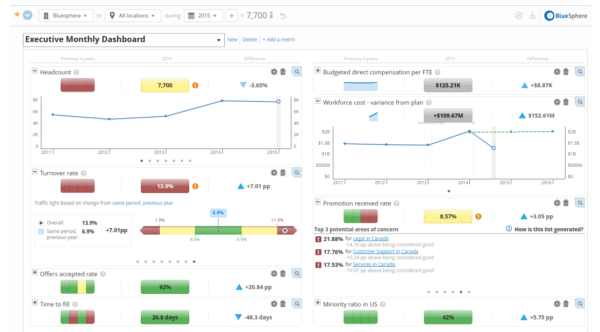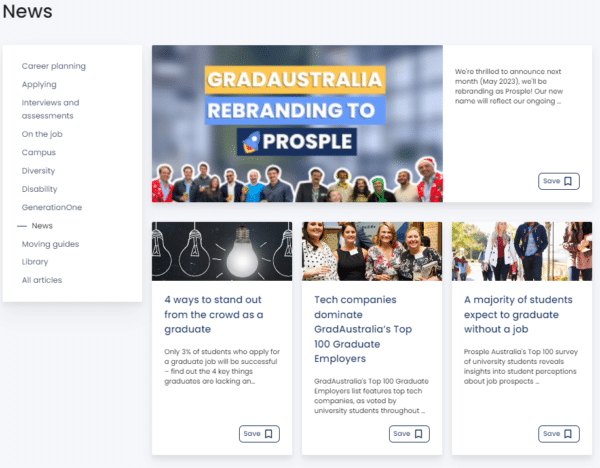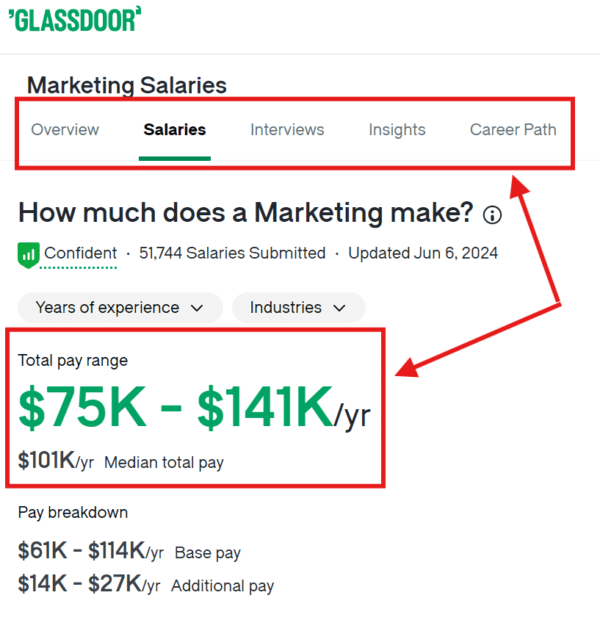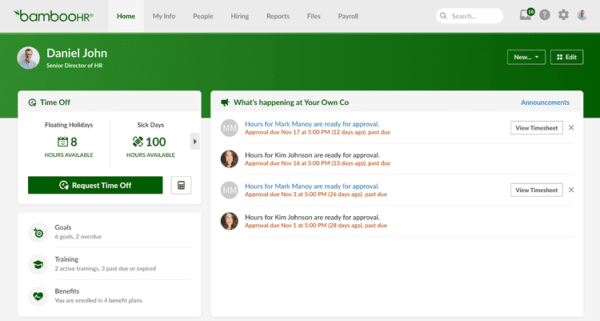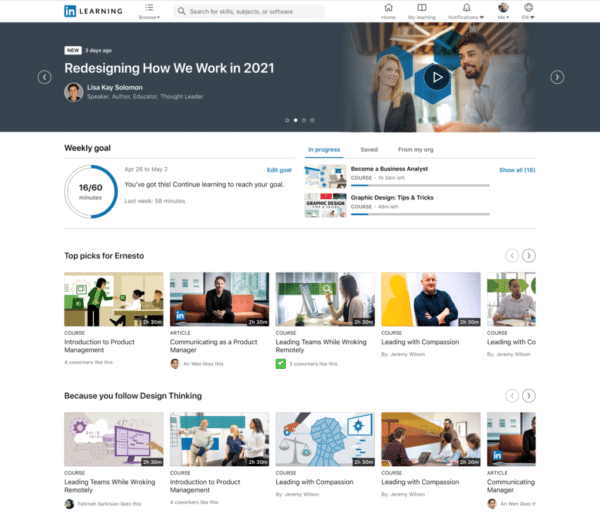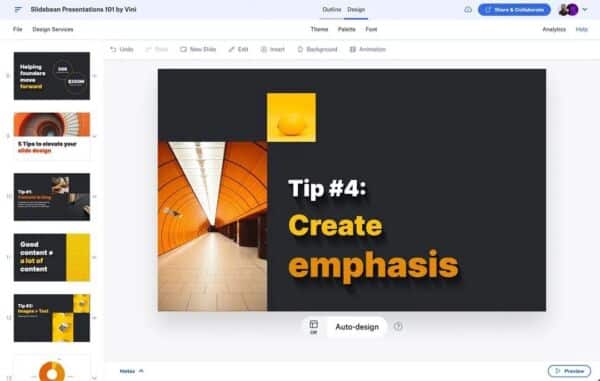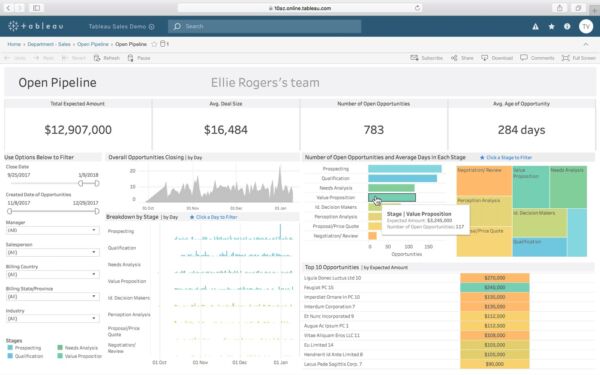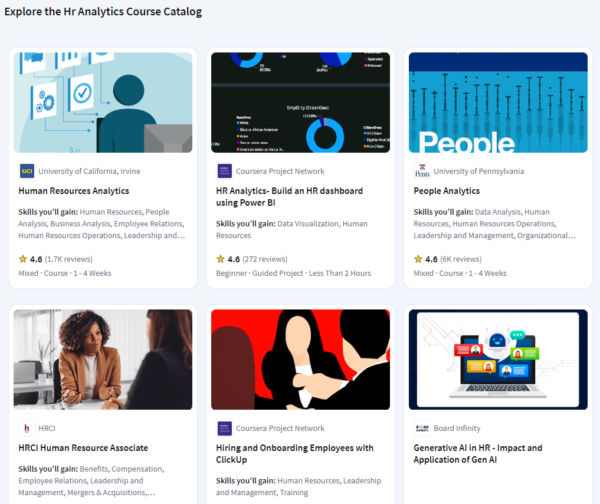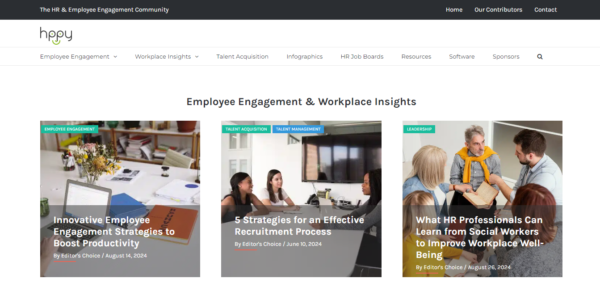Strong talent management strategies increase employee engagement by 16% and revenue by 19%.
So, in this article, we’ll explore effective talent management processes and engagement strategies to help you retain your top talent. Plus, we’ll discuss how you can improve your talent management process.
In the next 10 minutes, you’ll know how to build positive relationships with your employees, reduce turnover rates, and be ready to develop future leaders at work.
6 Effective Talent Management Strategies To Retain Top Performers
Review these strategies and see which ones you can use to nurture and manage talent and your top performers. As you go through them, find the ones that can help you fill gaps and engage your top talent before it’s too late.
1. Build A Stronger Stronger Talent Pipeline With Strategic Workforce Planning
Workforce planning is the top strategic priority for 70% of businesses. This means you have to strategically plan talent management and align talent needs with the overall business strategy. If you focus on strategic workforce planning, you can have the right people in the right roles at the right time.
Here’s what to do:
1.1. Conduct A Skills Gap Analysis
Assess your organization’s current skills and identify gaps using workforce analytics tools that align with your business objectives.
Let’s say your goal is to enhance your team’s web design capabilities. You’ll need to evaluate your team’s expertise in essential areas like HTML, CSS, and UX/UI design. After this, you’ll analyze and compare their web designing skills with industry standards or competitor benchmarks using trusted sources.
Based on the identified gaps, develop a plan to upskill current employees or recruit new talent to address these issues. Visier is a helpful tool for this. It lets you map out your team’s current skills, identify talent gaps, and model future workforce scenarios to ensure alignment with your strategic goals.
1.2. Use Global Talent Platforms
A global talent pool will expand your access to top talent and add diversity to your team. This means your workforce will have a wider range of skills and perspectives. For this, you need a headhunting agency like Genius that can source local talent from your target markets. They streamline the hiring process and help companies fill positions quickly and efficiently.
It specializes in finding highly skilled candidates from the Philippines and Latin America in different roles. They understand the local job markets and have the connections to find the right fit for your needs.
Another great platform to consider if you’re looking for freelance talent in tech and creative roles is Toptal. It has a rigorous vetting process that will help you find the cream of professional talent for critical projects.
1.3. Review Workforce Planning Regularly
Business needs continuously change, and your workforce plans should change with them. So, schedule regular reviews of your workforce plan, either quarterly or annually. This will ensure it aligns with your business’s evolving goals.
Use resources to stay updated on the latest workforce trends and developments. But make sure they’re specific to your area. For example, if you are based in Australia, Prosple is an excellent resource. It tracks the demand for various skills and industries in Australia. This information can help you anticipate future talent needs and adjust your hiring strategies accordingly.
Similarly, you can analyze the profiles of job seekers on Prosple to identify potential talent pools. It also shares articles and insights related to workforce trends, industry news, and best practices. This can help you stay informed and make better decisions about your hiring strategies.
Also, explore other job platforms that fit your specific needs. For example, Behance is a great starting point if you’re a design-focused company looking for creative talent. Alternatively, Glassdoor provides helpful insights into best practices and salaries if you are looking to hire US-based employees.
2. Develop Stronger Onboarding For Improved New Hire Productivity
A strong onboarding process can improve new hire retention by 82% and the productivity of high-performing employees by over 70%. Clearly, putting effort into smoothly integrating a new employee into your organization is essential. You must equip them with the right skills, tools, and knowledge they need to succeed.
Here’s what to do:
2.1. Automate Onboarding With Talent Management Software
Automating your onboarding process with advanced technology takes the hassle out of getting new hires up to speed, making it smoother and more efficient for everyone involved.
This can include:
- Sending out welcome emails
- Tracking training completion
- Scheduling orientation tasks
This process guarantees consistency in delivering information, reduced time spent on administrative tasks, and a more personalized employee experience for new hires.
BambooHR is an excellent tool that includes robust onboarding features. Use it to create detailed, role-specific onboarding checklists and make sure your new hires complete all the necessary tasks. These can include document signing, completing training modules, and meeting key team members.
This tool is especially helpful for mid-sized eCommerce companies. You can use it to automate the assignment of training courses and track progress through an easy-to-use dashboard. This will guarantee your new hires are fully prepared to contribute to the business’s growth.
2.2. Assign A Mentor
Pair new hires with experienced team members who can guide them. This is particularly useful in your employees’ first few months. A mentor can answer questions, provide feedback, and help them navigate company culture. Google’s “Noogler” onboarding program is a perfect example of this. It pairs new employees with mentors to accelerate their integration into the company’s culture and processes.
2.3. Customize Onboarding
Tailor the onboarding experience to the specific role and department. This will guarantee that new hires receive relevant and targeted information.
For example, if you have recently hired a software developer, provide them with access to the codebase, introduce them to the development team, and give them a rundown of the current projects and technologies in use.
Facebook’s customized onboarding process for engineers is an excellent example to consider. They assign an onboarding buddy to guide new hires through the initial weeks. Plus, they offer them access to a detailed onboarding portal with coding guidelines, internal documentation, training videos for their tech stack, and other resources.
3. Integrate Learning For Continuous Development & Sustained Employee Retention
94% of employees will stay at your company longer if you invest in their career development. This means that through continuous improvement, you’re creating a more loyal and committed team, while also cutting down on the costs and challenges of turnover.
Here’s what you need to know:
3.1. Create Personalized Learning Plans
This step is so important that brands like AT&T invest over $1 billion in retraining programs. This helps their workforce acquire new skills and significantly reduces turnover rates.
Start with discussing each employee’s career goals and current skill levels. Use the information collected to develop individualized learning plans. LinkedIn Learning is a great platform to access a wide range of courses for individual needs.
You can use its Learning Hub to create personalized learning plans and get recommendations for the most relevant courses based on each employee’s skills profile and learning activity.
Implement AI-powered chatbots like AeroChat that have knowledge integration capabilities to assist employees in real-time as they work through their learning plans. These chatbots can provide instant answers to questions, recommend additional resources, and track progress, making the learning experience more interactive and tailored.
3.2. Implement Regular Training Programs
Schedule quarterly workshops, webinars, and seminars that align with your company’s goals. Also, collaborate with in-house or outsourced content creation experts to create customer training content.
They can help you create customized training videos, internal documentation, and other resources that can be easily accessed and updated as your company evolves. Make sure to track employee progress and gather feedback (more on this later) after each session to continuously improve the content and ensure it meets the needs of your team.
Consider setting up a learning management system (LMS) to organize and distribute these materials effectively. This will make ongoing learning a seamless part of your company’s culture.
Also, make training a regular part of your team’s routine by dedicating a set time each week for skill development. Whether it’s an hour for a quick learning session or a half-day deep dive, keep it consistent so that everyone is engaged and growing.
3.3. Use Real-Time Feedback
Add feedback loops in your learning programs to continuously monitor and improve the learning experience. Begin with regular data collection on employee engagement and progress during your training sessions.
You can use surveys, quizzes, or direct feedback sessions to gather insights on what you need to improve. For example, after each training session, send out a quick survey asking employees what they found most helpful and where they’d like more support.
Review quiz results to see if there are common areas where people struggle and adjust your materials accordingly. Set up regular check-ins, like monthly reviews, to discuss progress and tweak the training program based on real-time feedback. This way, you’re always fine-tuning your approach to better support your team’s growth.
4. Craft An Employer Brand To Attract Top Talent
75% of job seekers consider an employer’s brand before even applying for a job. This calls for companies to create a strong employer brand if they want to attract top talent.
Here’s how to do it:
4.1. Showcase Company Culture
Highlight your company’s culture and values on your website and social media channels. Start by creating a dedicated “Culture” page on your website where you can share stories, videos, and photos that show what it’s like to work at your company. Use platforms like Glassdoor to gather and display employee testimonials that showcase your workplace environment.
Go beyond words and add short video clips of employees talking about their experiences and what they love about working there. This adds a personal touch that text alone can’t capture. You can even do quick “day in the life” features to give potential hires a real feel for the workplace vibe.
4.2. Develop A Compelling Employer Value Proposition (EVP)
This is a critical element in attracting and retaining top talent. To communicate your EVP effectively, create a well-designed presentation that outlines the benefits and unique aspects of working at your company.
Use tools like Slidebean to craft these presentations with professional templates that are easy to customize. It lets you create an engaging pitch deck that visually highlights what makes your company unique. You can easily add compelling visuals, clear text, and even interactive elements to make your EVP stand out. This helps you tell your story in a way that’s both professional and inviting.
Include testimonials from current employees to add authenticity and give potential candidates a real sense of what it’s like to work at your company. Make sure to address common questions or concerns about career development, work-life balance, and company culture.
Additionally, share the presentation on your careers page, social media channels, and during interviews to consistently reinforce your EVP. Regularly update the content to reflect any changes or new benefits.
4.3. Use Social Media
Social media is a powerful tool for shaping and showcasing your employer brand. Share behind-the-scenes content that highlights your workplace culture, team events, and employee stories. Use Instagram Stories, LinkedIn posts, and Facebook updates to give potential candidates a glimpse into daily life at your company.
Use Google Analytics to keep a close eye on how your social media posts are performing. Check which content gets the most engagement and what’s driving traffic to your careers page. This way, you’ll know exactly what’s working and can tweak your strategy to attract the right candidates.
If managing these aspects feels overwhelming, hire the help of a marketing agency. They can optimize your social media presence and help you craft targeted campaigns that align with your employer’s brand goals.
You can also celebrate the achievements and milestones of your team members. Promotions, awards, and project successes – all these show how you value and recognize your employees. Also, encourage your employees to share their own experiences and job-related content on their personal social media accounts. This expands your reach and adds authenticity to your employer brand.
4.4. Host Virtual Open Houses
Virtual open houses are a fantastic way to give potential candidates an inside look at your company without any pressure. Start by setting up virtual tours of your office (even if it’s remote), and include interactive Q&A sessions with different team members. Let candidates meet your team and ask real questions about the work environment and company culture.
Feature live demonstrations or presentations of ongoing projects or initiatives. This helps candidates see the kind of work they might be involved in and understand the impact they could make.
You can also have current employees share their personal experiences in a relaxed, informal setting. Let them talk about their career growth, favorite projects, and why they love working for your company.
After the virtual open house, send personalized follow-up emails with additional resources, like team blogs, company culture videos, and upcoming events. This keeps the conversation going and reinforces your employer brand.
5. Make Data-Driven Decisions For Optimized HR Operations & Talent Management Practices
Data-driven decision-making helps 83% of businesses boost their operations by using clear, evidence-based insights to shape their strategies.
Therefore, it’s important to invest in robust data analytics tools and practices. Gone are the days of relying on intuition or gut feelings. When you start analyzing your data regularly, you can identify trends, make informed decisions, and fine-tune your strategies for better results.
Here’s what you need to do:
5.1. Invest In Analytics Tools
Use advanced analytics platforms like Power BI or Tableau to collect and analyze HR data.
Tableau offers powerful visualization tools that make it easier for you to create interactive dashboards to track key HR metrics, like employee turnover rates and performance trends. Use it to set up real-time reports that you can easily share with your team. Dive into the data to spot patterns and trends, and make informed decisions on how to improve employee retention and performance.
You can also customize alerts for important metrics, so you stay proactive rather than reactive. This way, you can keep an eye on the numbers and use them for actionable improvements in your HR strategies.
5.2. Train HR Teams In Data Analytics
Offer training programs that focus on interpreting data and applying insights to make sure your HR team is skilled in data analysis.
Host workshops or online courses that teach them how to use tools like Tableau or Excel for analyzing trends and creating reports. Make it hands-on by using real company data in practice sessions so they can see the impact of their work. Regularly update the training with new techniques and insights to keep their skills sharp.
Use courses from Coursera to upskill your team. They’ve developed specialized training programs that focus on real-world applications to make it easier for HR professionals to translate complex data insights into strategic actions.
5.3. Enhance Data Accuracy
Accurate data collection and interpretation are important to make better decisions. Implement regular data audits and cleaning procedures. Set up a schedule to review and update your HR data to correct any inaccuracies and remove outdated information. Set aside time each month to purge outdated information and update records. This includes removing inactive employees, correcting job titles, and refreshing contact details.
Invest in tools that automate data entry and integration to reduce human error. Make sure your team is trained on best practices for data management to ensure everyone is on the same page. Automate routine data entry tasks where possible, like onboarding new employees or updating training records. It reduces human error and speeds up data management.
6. Introduce Recognition Programs To Boost Employee Loyalty
You can lower your voluntary turnover rate by 31% with regular employee recognition programs. This shows how important it is to consistently acknowledge and reward your team for their hard work. When employees feel valued and appreciated, they’re more likely to stay loyal to your company.
Here’s what you can do:
6.1. Create A Recognition Program
Create a structured recognition program that includes both peer-to-peer and manager-to-employee recognition. Define what types of achievements and behaviors will be recognized. Whether it’s hitting sales targets, going above and beyond in customer service, or demonstrating teamwork, make sure everyone knows what to look out for.
Use a platform or app where employees can easily give and receive recognition. Tools like Kudos or Bonusly allow team members to send shout-outs and awards. Create a system where employees can nominate their peers for recognition. This can be done through a monthly or quarterly award program where nominations are reviewed and winners are announced in team meetings.
Make sure managers regularly recognize their team’s hard work. This could be through monthly one-on-one meetings where managers highlight individual accomplishments or through team-wide announcements in meetings or newsletters.
6.2. Tie Recognition To Company Values
Align recognition with your company’s core values to maximize its impact. Recognize employees who consistently exemplify these values in their work.
This means spotting the behaviors and actions that reflect your company values and explicitly recognizing employees who demonstrate them in their daily work lives. For example, if customer service is a core value, reward employees who go above and beyond in their customer interactions.
Start by clearly defining your core values and creating recognition criteria that reflect those values. Then, make sure that recognition is consistent and visible to other employees to help them understand which behaviors are valued.
How To Create A Successful Talent Management Strategy For Business Growth
99% of employees who believe their employer’s talent management is effective also believe that the company outperforms its competitors. Look at these steps and think of how you can incorporate them to create a structured process to align your HR strategy with your business goals.
A. Talent Acquisition
- Start by creating detailed job descriptions that clearly outline the skills, experience, and qualifications needed. This ensures you attract candidates who are a good fit for both the role and your company culture.
- Use a mix of job boards, social media, and employee referrals to reach a diverse pool of candidates. Platforms like LinkedIn and industry-specific job sites can help you find top talent more efficiently.
- Develop a structured screening process that includes pre-interview assessments and structured interviews. This helps you evaluate candidates consistently and fairly, ensuring you select the best fit for the role.
- Make sure your hiring process is efficient and candidate-friendly. Communicate clearly about each stage, provide timely feedback, and make the onboarding process smooth.
- If you’re hiring in a community where many potential candidates speak a specific language, consider writing your job posts in that language.
Fortune Restoration is our favorite example of how to use this strategy effectively, and it’s a smart practice worth adopting. They’re based in Chicago, IL but they go the extra mile by posting jobs in Spanish and other languages that match the demographics of their target employees.
This thoughtful approach makes their job openings much more accessible, lets them connect with the right candidates, and shows they genuinely care about inclusivity. It’s a simple step that is significantly broadening their reach and attracting talent that might otherwise overlook their listings.
B. Performance Management Strategies
- At the start of each review period, work with employees to set specific, measurable goals that align with your company’s objectives. Make sure these goals are realistic and provide clear benchmarks for success.
- Instead of waiting for annual reviews, schedule regular one-on-one meetings with employees. Use these check-ins to discuss progress, address issues, and provide timely feedback. This keeps everyone on track and allows for adjustments throughout the year.
- Develop KPIs relevant to each role and track them consistently. Tools like performance management software can help you monitor metrics and generate reports to assess individual and team performance.
- Encourage a culture of continuous feedback where employees receive constructive input regularly, not just during formal reviews. Use tools like feedback apps or regular team meetings to facilitate ongoing communication.
C. Employee Engagement
- Use quick, frequent surveys to gauge employee satisfaction and gather feedback on various aspects of their work environment. Tools like SurveyMonkey or TinyPulse can help you identify areas for improvement and act on employee concerns promptly.
- Create a system where employees can easily recognize and reward their peers for outstanding work. Whether it’s a digital shout-out platform or a monthly awards ceremony, make sure recognition is timely and meaningful.
- Support flexible work arrangements and encourage employees to take time off when needed. Offer wellness programs or initiatives that help employees manage stress and maintain a healthy work-life balance.
- Plan regular activities that bring your team together, whether it’s virtual hangouts, team outings, or collaborative workshops. These activities build camaraderie and strengthen team relationships.
- Hppy is your go-to resource for increasing employee engagement. It offers the latest research, expert advice, and real-world examples that can help you create a more positive and productive work environment. From improving recognition programs to fostering a healthier workplace culture, Hppy provides the resources you need to elevate employee engagement.”
D. Learning & Development Initiatives
- Work with each employee to develop a learning plan tailored to their career goals and skill gaps. This could include courses, certifications, or projects that align with both their interests and your company’s needs.
- Provide different learning formats, like online courses, workshops, and webinars, to accommodate different learning styles and schedules.
- Set up internal knowledge-sharing sessions where team members can present on topics of expertise or recent projects.
- Find ways to incorporate learning into everyday tasks. For example, assign stretch projects that push employees to develop new skills or pair them with mentors for on-the-job training.
E. Succession Planning
- Start by pinpointing critical roles within your organization that are essential for its success. Then, identify potential successors from within your team who have the skills and ambition to step into these roles.
- For each potential successor, outline a clear development path that includes specific skills and experiences they need to gain.
- Schedule periodic reviews of your succession plans to ensure they stay relevant. Update them based on changes in the company, evolving business needs, or shifts in employee performance and career aspirations.
- Give your high-potential employees opportunities to lead important projects or initiatives. This prepares them for future roles and helps them gain the experience and visibility needed for a smooth transition.
Conclusion
Keeping top talent around isn’t just about throwing money at them. It’s about showing them that they’re valued and they’re part of something bigger. With the right talent management strategies, you can put in more so you can get out more. When they feel appreciated, they’re more likely to stay, work harder, and bring their best every day.
Need more help? Hppy can support you in designing and implementing effective talent management and employee engagement strategies that align with your business’s goals. Start exploring to create a workplace where top talent flourishes.
